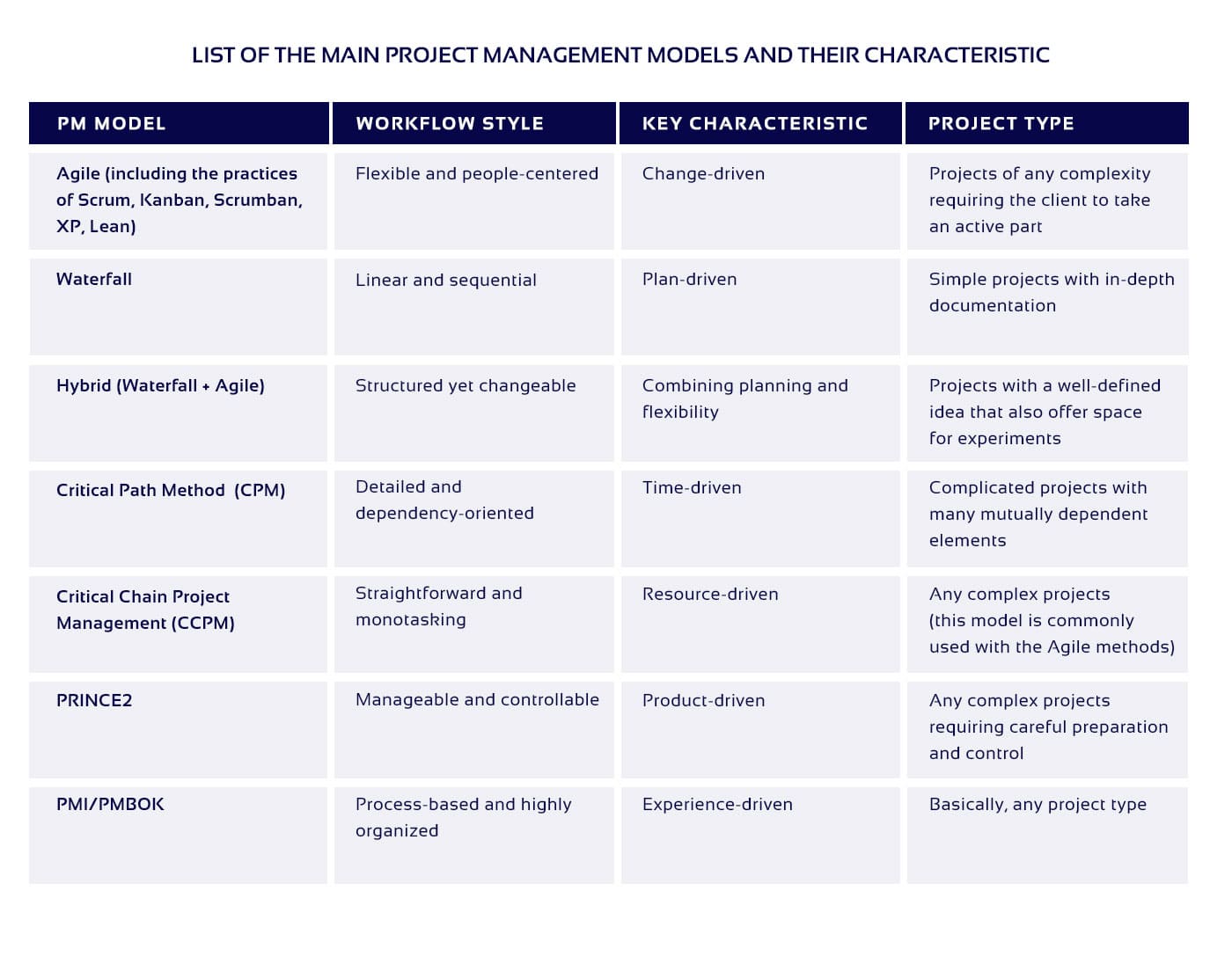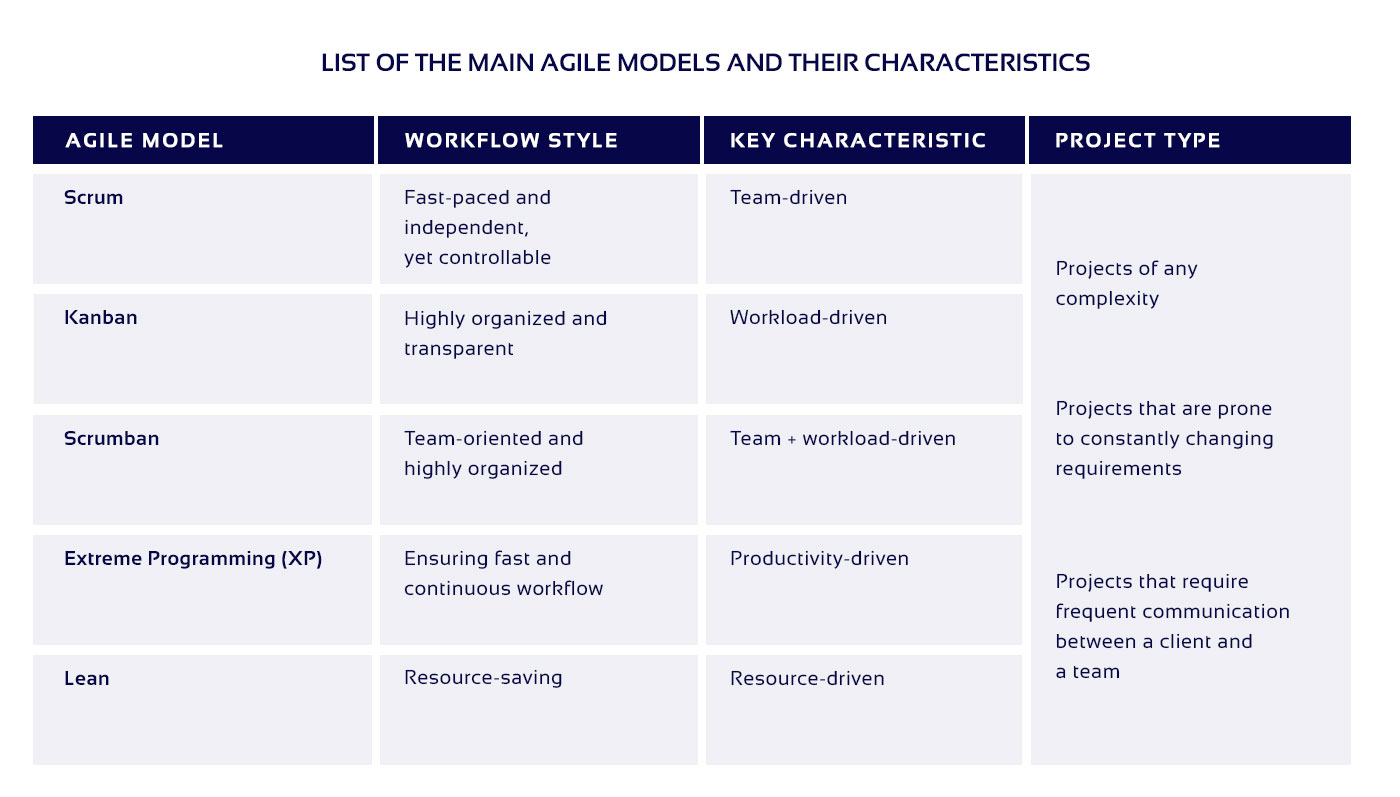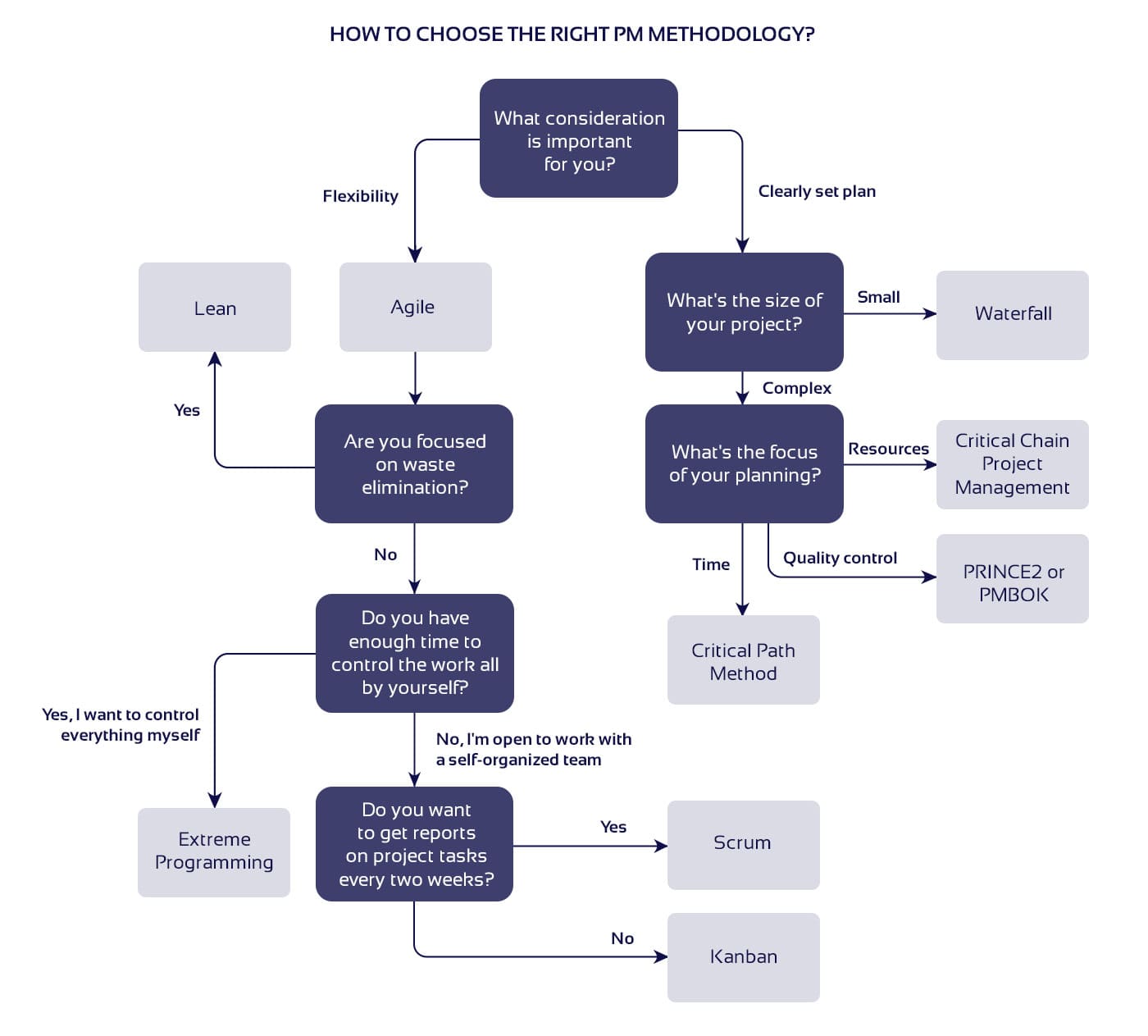Project management methods aim at organizing and optimizing software development processes. In the past, many IT companies didn’t realize the importance of project management and even had no such specialists as Project Managers. Basically, there was only a developer or a team of developers and a client who directly communicated with each other, discussed the requirements and the workflow, etc.
Such work organization had many flaws because developers had to deal with many processes instead of doing their direct job – coding. As a result, developers faced work overload, poor productivity, and missed deadlines.
The IT field is also famous for its love to optimize business processes; thus, many software engineering companies developed several project management approaches to replace the “developer-client” model.
Even though today the situation is different, the clients of software development companies don’t know what PM approaches to managing the development process suit their particular cases. So, if you’re a business or a startup owner, this article will give you enough information about the most popular project management techniques and methodologies and when to use them.
What Is a Project Management Methodology?
A project management methodology is a way of organizing the software development process using a set of principles, guidelines, tools, communication channels, etc. Since every methodology is based on a certain set of rules, it is important to choose the right one to meet the client’s requirements.
There’s a great variety of project organizing approaches to choose from. The origin of all widely used modern project management methodologies dates back to the 1980-1990s. The fact that they still exist after the decades shows their undeniable value and contribution to the software quality.
List of the Most Used PM Methodologies
The reason why these methodologies successfully exist today lies in the fact that they include both traditional plan-driven methodologies and change-oriented strategies; thus, they are flexible. Even though their workflow style and key features differ, they all focus on ensuring a high-quality result.

1. Agile Project Management Methodology
Agile is an IT project methodology that puts flexibility above all. It primarily focuses on meeting constantly changing requirements and continuous work improvement. This project organization approach allows dividing a complex project into small development tasks and short cycles (sprints). Usually, there are three or five sprints per project. At the end of each sprint, the team reevaluates the work done and, if needed, sets the new development priorities based on the results. What the Agile method offers clients:
- a team is always in touch with the client and is ready to provide reports on the progress, receive feedback, and follow new requirements;
- a client can actively take part in the development process; thus, the project control increases because of the frequent team and client meetings;
- the ability to change the requirements at any stage of the development process;
- higher product quality due to constant planning and testing;
- special PM tools (Jira, Trello, etc.) that ensure transparency of every work process;
- efficient risk management due to continuous planning, frequent reporting on the results, and higher adaptation to the clients’ needs according to their feedbacks;
- faster ROI because of the early start of the development process, short delivery cycles, and the full understanding of clients’ business and priorities.
Note: The Agile methodology is also an umbrella term for a bunch of flexible narrow-focused PM frameworks that are going to be unveiled further in this article.When to use the Agile models:
- if a client doesn’t have a clear vision of the future product;
- when the project is expected to be unpredictable and prone to constantly changing requirements;
- when the client wants to get the frequent results and receive the product faster;
- if a client considers communication to be the most convenient way to control the project.

2. The Agile-Based Scrum Method
Scrum is an Agile-based methodology that pursues similar goals as Agile but differs from it by a strong focus on teamwork. This PM method includes the product owner and scrum master roles besides the development team.
A product owner is responsible for the entire product creation process and the final result. This person must think like a business analyst, a marketer, a client, and an end user combined to meet the client’s requirements. A scrum master makes sure that the team follows the Scrum principles.
Scrum is based on six fundamental principles:- Empirical control of processes. Scrum underlines the principles of transparency, inspection, and adaptation. The transparency principle implies that every participant can freely observe any Scrum process. Project inspection is about getting feedbacks and approval of the results from the client, and using a common board to organize and follow the workflow. The adaptation processes generally include frequent Scrum meetings, risk handling, and making changes into the product.
- Time-boxing. One sprint usually lasts 15 or 30 days. By the end of each sprint, a team must accomplish the planned amount of work and prepare it for the client’s review. If the client approves the results, the team gets further instructions for the next sprint.
- Collaboration. Scrum focuses on people because the quality of the work primarily depends on the staff's overall productivity. Daily stand-up meetings help scrum masters control the team progress and keep each team member motivated.
- Self-organized cross-functional teams. Specialists organize their teamwork by themselves. In case someone leaves the team for some reason, another team member or a group of specialists can replace them without productivity loss.
- Prioritization of tasks. The team sets priorities for tasks based on their business value. So, to fulfill the client’s business requirements, the team must deliver the features of the highest priority first.
- Iterative approach. This principle lies in dividing large projects into smaller tasks. It helps to set clear responsibilities for each team member and define the most efficient ways to implement changes.
3. Kanban Method in the Agile Framework
Kanban is another popular Agile framework that underlines the importance of continuous workflow considering the team’s capacity and the transparency of processes between team members. The fundamental tool here is a Kanban board – the space where teams and clients can see the progress on tasks. If you’ve ever used Jira Software, Trello, or similar project management tools, you are no stranger to the Kanban approach.
Interesting fact: The word “Kanban” came from Japanese “billboard,” “visual card” or, more precisely, “the card you can see.”The principles of Kanban in the development process are:
- List of work processes, columns, and lines. These elements frame the whole scope of work that must be done. They also make possible to check the tasks’ status and progress of every specialist on the project;
- WIP limits. The work in progress (WIP) limits define the amount of work that can be done by the team based on its capacity;
- Continuous delivery. The Kanban task organization allows your team to develop, test, and deliver new functionalities continuously.
4. Scrum + Kanban = Scrumban
Some companies mix up both Scrum and Kanban tools in different variations or switch from Scrum to Kanban, and vice versa. Usually, teams follow the work strategy of Scrum and keep the organizational style of Kanban. Thus, the approach emphasizes well-coordinated teamwork, fast-paced development style, and the usage of boards that arrange the work processes keeping them transparent.
5. Extreme Programming (XP)
This Agile-based methodology focuses on software quality improvement and increasing responsiveness to changes in requirements. Basically, XP implies traditional software development practices, except, they are taken to extreme levels in terms of task delivery speed. Extreme programming intends to save costs and other resources on development by eliminating unproductive activities and making development cycles short to achieve frequent releases.
The most prominent technique to highlight here is pair programming, which implies two developers working together on the same computer. One of them writes code and the other one reviews each string of code the moment it’s ready. After some time, they switch roles to increase their productivity and code quality.
6. Lean Software Development (LSD)
The Lean model absorbed all fundamental principles of Agile such as short iterations, client-oriented nature, team motivation, etc. However, the most distinctive features of Lean focus on waste elimination, team engagement, and following the principle: “Decide as late as possible, deliver as fast as possible”:
- Waste management. Everything that has no value for the client and users is considered as a waste. These can be additional functionalities that weren’t discussed, delays, defects, miscommunication between a team and a client, etc.
- Team engagement. Every team member must do their best to ensure the project's success and be interested in the development process as if they are developing their own product. However, this rule must be applicable to whatever methodology you use.
- Deciding as late as possible. The team must make decisions out of the current outcomes, not the assumptions or predictions.
- Delivering as fast as possible. This rule is about having the right people in a team, keeping requirements and technical solutions simple, building quality, etc.
7. Waterfall Project Management Methodology
Waterfall is a traditional project management approach. As the name suggests, the development process must run like a waterfall, and all stages should be completed in a strict sequential order. The general list of the Waterfall processes includes requirements analysis, design, implementation, validation, and maintenance of a software product.
The main rules of Waterfall are:- requirements and dependencies must be settled before the development process starts;
- management must have metrics and documentation;
- quality should be of a higher priority than speed;
- the next stage cannot begin until all tasks on a certain project stage are completed;
- when a certain stage is done, it’s not possible to return to this stage anymore;
- the plan must stay unchangeable, and no overlapping tasks are allowed; however, ensuring the parallel work of two teams is possible.
- in simple fixed-price projects;
- when a client has explicit requirements for the project and the product.
8. Hybrid Approach (Waterfall + Agile)
The hybrid approach combines the best means of Waterfall and Agile management models. The Waterfall part lies in the meticulous requirements collection and analysis. The Agile approach gave this project management method its iteration-based workflow that allows teams to focus on critical tasks.
When to use:- if a project is of the middle size and medium complexity;
- if a project has a well-defined idea that also provides some space for experiments.
9. Critical Chain Project Management (CCPM)
Critical chain project management is an alternative to the CPM model. If the CPM model focuses on timing, the CCPM emphasizes the resources (human resources, hardware, equipment, etc.). This may sound a little weird, but when using this methodology, you start from the end. The team analyses the deliverables and resources they have, and only after that, sets the dependencies between the resources to form the tasks that must be accomplished. The principles of CCPM are:
- no multitasking;
- focus on critical tasks;
- the time to create a project is estimated based on 100% workload for a specialist;
- no dead time at work thanks to special instruments called buffers.
- any complex projects (however, in software development, it must be used in combination with Agile methodologies to ensure flexibility and multitasking).
10. Critical Path Method (CPM)
The CPM method involves creating a detailed list of mini-tasks for complex operations and setting dependencies between them. This method helps to define the trickiest factors of the development process that could negatively affect the result. Based on these factors, the team can estimate the most critical deadline/time and define the efforts required to accomplish the project. You can see how it works from a simple real-life example. Suppose you need to make a phone call. Your tasks could be arranged as follows:
- Take the phone;
- Go to your contacts;
- Choose the person you want to talk to;
- Dial their phone number.
In this case, dialing a specific phone number depends on who you decided to call. Making a call depends on the way you dialed a phone number. The same goes for developing a software product, some upcoming tasks will depend on the previous ones and that’s what will define the team workflow, especially the timing.
When to use:- complex projects with many mutually dependent elements;
- urgent projects, when the speed of development matters a lot.
11. PRINCE2 Project Management Methodology
PRINCE2 (PRojects IN Controlled Environments) is a standard for the information systems projects approved by the British government that is adopted in the UK, some European countries, and Australia. It proclaims the principles of high control and clearly defined responsibilities between team members.
In brief, PRINCE2 is a structural approach that’s managed stage by stage. Its distinctive feature is the role of a project board that’s responsible for quality control. A project board is a commission that includes a client, the main user, and the main specialist who checks the project at every stage and make decisions based on the results. So, this approach can be characterized as highly controllable and scrutinous.
When to use:- any complex project requiring careful planning and control;
- when the client knows exactly what they want to have on the project.
12. PMI/PMBOK (Project Management Body of Knowledge)
This one isn’t a method but an essential standard for managing projects popular in the US and Western Europe. Project Management Institute (PMI) is a professional project management organization that created the Project Management Body of Knowledge (PMBOK) guidelines. These guidelines are based upon the experience of various companies in project delivering and their best practices. The standard defines the 10 PM knowledge areas and 47 processes that a manager must follow to deliver a high-quality software product. The knowledge areas cover:
- Integration management;
- Scope management;
- Schedule management;
- Cost management;
- Quality management;
- Human resources management;
- Communications management;
- Risk management;
- Procurement management;
- Stakeholder management.
- Project initiation;
- Planning;
- Executing;
- Monitoring and control;
- Closing.
- since PMI/PMBOK is a comprehensive standard for managing projects, specialists rely on it when working on any type of project.
How to Choose the Right Methodology?
Even though all methods differ from each other, they were made to ensure high quality of projects by cutting development costs, handling resources effectively, reducing risks, etc. The choice of a managing method depends on the project and client’s priorities, that’s why a client and a project manager should:
- Evaluate the Project. Questions like “What is the size of the project?”, “How complex is it?”, “Would there be any changes or experiments?” must have clear answers before the project begins.
- Define Priorities. While some PM models concentrate on processes, tasks, and risks, others focus on people, teamwork, resources, and productivity. Below is the table that’ll help you choose the method based on what you expect to get in your project.

What Project Management Models We Use
Specialists at any software engineering company would say that there are no two similar IT projects, and sometimes it is not easy to choose the most suitable PM methodology. Since our specialists work on radically different types, sizes and complexity of projects, we decided not to stick to only one project management approach and created various hybrid combinations of methodologies, which allows us to reach top-level efficiency for all kinds of our software development processes. When defining a PM methodology for a project we strive to achieve maximum:
- Flexibility. We listen and change. The team focuses on creating comfortable conditions for cooperation and choosing the most convenient method based on the client’s needs. Be it a general concept of new web software or an ongoing mobile development project that needs an upgrade or improvement, we will provide a narrow-focused methodology for each specific case.
- Reasoning. We think first and then do. To understand what exact methodology fits a particular business idea most, we thoroughly analyze functional and non-functional requirements, evaluate the complexity of the system’s architecture, consider our experience on previous projects with as similar parameters as possible, and so on.
- Giving more than expected. Our goal is to be valued by our clients for the commitment and high quality of our work. Depending on our expertise in the client’s field, we nearly always suggest technical or business improvements for the clients’ software. We do it not because we want to give more than our competitors, but simply because we truly love what we do and want to create great things that would bring companies, and even entire industries to the new advanced level!
Final Words
Some methodologies imply that the development team must strictly follow the unchangeable requirements until the product release. Others emphasize flexibility and efficient communication between a client and a development team. So, the principle of choosing a method entirely depends on needs, priorities, and resources as this world has no one-size-fits-all approach to project management.
If you need to evaluate your project and define the methodology according to its peculiarities, don’t hesitate to contact us for assistance. Our project managers will help you build the right strategy for your specific case based on your requirements and our expertise in your niche.




